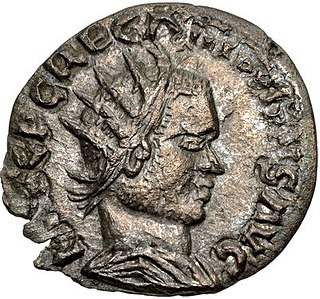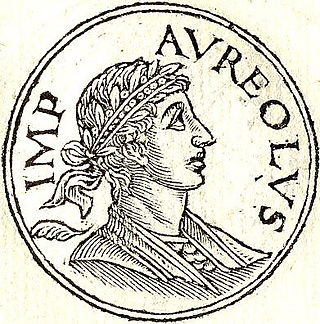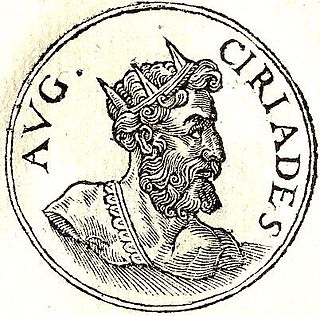
Publius Licinius Egnatius Gallienus was Roman emperor with his father Valerian from 253 to 260 and alone from 260 to 268. He ruled during the Crisis of the Third Century that nearly caused the collapse of the empire. He won numerous military victories against usurpers and Germanic tribes, but was unable to prevent the secession of important provinces. His 15-year reign was the longest in half a century.

Marcus Cassianius Latinius Postumus was a Roman commander of Batavian origin, who ruled as emperor of the splinter state of the Roman Empire known to modern historians as the Gallic Empire. The Roman army in Gaul threw off its allegiance to emperor Gallienus around the year 260, and Postumus assumed the title and powers of Emperor in the provinces of Gaul, Germania, Britannia, and Hispania. He ruled for the better part of ten years before he was murdered by his own troops.

The Historia Augusta is a late Roman collection of biographies, written in Latin, of the Roman emperors, their junior colleagues, designated heirs and usurpers from 117 to 284. Supposedly modeled on the similar work of Suetonius, The Twelve Caesars, it presents itself as a compilation of works by six different authors, collectively known as the Scriptores Historiae Augustae, written during the reigns of Diocletian and Constantine I and addressed to those emperors or other important personages in Ancient Rome. The collection, as extant, comprises thirty biographies, most of which contain the life of a single emperor, but some include a group of two or more, grouped together merely because these emperors were either similar or contemporaneous.

Gaius Pius Esuvius Tetricus was a Gallo-Roman nobleman who ruled as emperor of the Gallic Empire from 271 to 274 AD. He was originally the praeses of Gallia Aquitania and became emperor after the murder of Emperor Victorinus in 271, with the support of Victorinus's mother, Victoria. During his reign, he faced external pressure from Germanic raiders, who pillaged the eastern and northern parts of his empire, and the Roman Empire, from which the Gallic Empire had seceded. He also faced increasing internal pressure, which led him to declare his son, Tetricus II, caesar in 273 and possibly co-emperor in 274, although this is debated. The Roman emperor Aurelian invaded in 273 or 274, leading to the Battle of Châlons, at which Tetricus surrendered. Whether this capitulation was the result of a secret agreement between Tetricus and Aurelian or that surrender was necessary after his defeat is debated. Aurelian spared Tetricus, and made him a senator and the corrector (governor) of Lucania et Bruttium. Tetricus died of natural causes a few years after 274.

Ingenuus was a Roman military commander, the imperial legate in Pannonia, who became a usurper to the throne of the emperor Gallienus when he led a brief and unsuccessful revolt in the year 260. Appointed by Gallienus himself, Ingenuus served him well by repulsing a Sarmatian invasion and securing the Pannonian border, at least temporarily. Ingenuus had also been charged with the military education of Caesar Cornelius Licinius Valerianus, the young son of Emperor Gallienus, but after the boy's death in 258, his position became perilous.

P. C. Regalianus, also known as Regalian, was Roman usurper for a few months in 260 and/or 261, during the Crisis of the Third Century, a period of intense political instability in the Roman Empire. Regalianus was acclaimed emperor by the troops along the Danube river, a region of the empire that frequently experienced barbarian raids, probably in the hope that he might be able to secure the frontier.

Titus Fulvius Junius Quietus was a Roman usurper against Roman Emperor Gallienus.

Lucius Mussius AemilianussignoAegippius was a Roman who held a number of military and civilian positions during the middle of the third century. He is best known as a Roman usurper during the reign of Gallienus.

Aureolus was a Roman military commander during the reign of Emperor Gallienus before he attempted to usurp the Roman Empire. After turning against Gallienus, Aureolus was killed during the political turmoil that surrounded the Emperor's assassination in a conspiracy orchestrated by his senior officers. Aureolus is known as one of the Thirty Tyrants and is referenced in ancient sources including the Historia Augusta, Zonaras' epitome and Zosimus' Historia Nova.
Julius Asclepiodotus was a Roman praetorian prefect who, according to the Historia Augusta, served under the emperors Aurelian, Probus and Diocletian, and was consul in 292. In 296, he assisted the western Caesar Constantius Chlorus in re-establishing Roman rule in Britain, following the illegal rules of Carausius and Allectus.
The Thirty Tyrants were a series of thirty rulers who appear in the Historia Augusta, as having ostensibly been pretenders to the throne of the Roman Empire during the reign of the emperor Gallienus.
Balista or Ballista, also known in the sources with the name of "Callistus", was one of the Thirty Tyrants of the controversial Historia Augusta, and supported the rebellion of the Macriani against Emperor Gallienus.

Cyriades was a Roman rebel who betrayed the city of Antioch to the Sasanian King Shapur I sometime during the 250s. His chief claim to fame is that he is enumerated as one of the Thirty Tyrants who supposedly tried to overthrow the emperor Gallienus.

Trebellianus was a Roman usurper listed among the thirty tyrants in the Historia Augusta. Modern historians consider this figure a character invented by the author of Historia, whose traditional name was Trebellius Pollio.
The Gallienus usurpers were the usurpers who claimed imperial power during the reign of Gallienus. The existence of usurpers during the Crisis of the Third Century was very common, and the high number of usurpers fought by Gallienus is due to his long rule; fifteen years being considered long by the standards of the 3rd century Roman Empire.

Lucius Calpurnius Piso Frugi was probably a Roman general whom the imperial pretender Macrianus Major sent to suppress the governor of Achaia, Valens Thessalonicus. His existence is attested only by the unreliable Historia Augusta, which labels Piso as one of several usurpers who plagued the reign of Emperor Gallienus. While some historians grudgingly regard Piso as a historical figure, many reported details of his life, including his usurpation, are dismissed as fabrications.
Clearchus was a citizen of Heraclea on the Euxine who was recalled from exile by the oligarchy of that city to aid them in quelling the growing discontent and demands of the people. According to Justin, Clearchus reached an agreement with Mithridates of Cius to betray the city to him on the condition that Clearchus would hold the city for Mithridates as governor. But, Clearchus then came to the conclusion that he could make himself master of the city without the aid of Mithridates. So he not only broke his agreement with the Mithridates, but also captured him and compelled him to pay a large sum for his release.

Appius Claudius Censorinus was a fictitious usurper against Roman Emperor Claudius II, according to the unreliable Historia Augusta. He is included in the list of the Thirty Tyrants.

In the Historia Augusta, Postumus the Younger figures as one of the so-called Thirty Tyrants who usurped power against the Roman Emperor Gallienus. According to the pseudo-historical list of 'Thirty Tyrants', the Emperor of the Gallic Empire Postumus had a son, also called Postumus, whom he nominated to be first caesar, and later even augustus and co-ruler. Postumus the Younger would have been killed together with his father in 268, during the rebellion of Laelianus.
The name Alcon or Alco can refer to a number of people from classical history:














